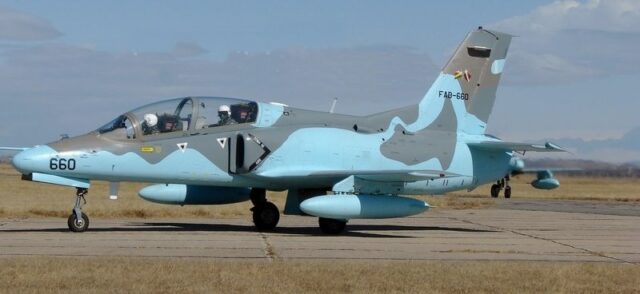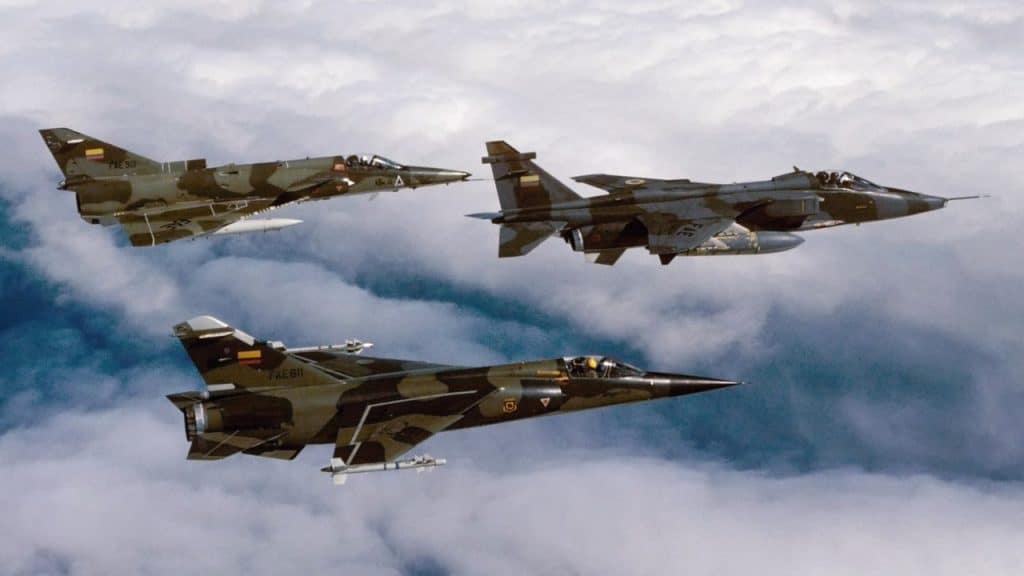The search for new multi-role combat aircraft is currently underway in the air force of several South American countries. We write regularly about the adventures of Argentina and Colombia, so let’s devote a moment today to other countries of this continent, often neglected apart from the Spanish-speaking media – Bolivia and Ecuador.
Ecuador
The Fuerza Aérea Ecuatoriana can boast a long history (it will be celebrating its 102nd birthday in a few days) and an interesting list of aircraft used in the past. The first jet fighters in this country were Glosters Meteora FR.9, purchased from the Royal Air Force in 1954. Soon after, the Shooting Stary – the F-80 fighter and the T-33 training and training – and the English Electric Canberra B.6 bombers arrived.
In the mid-seventies, a generational change began. The BAC Strikemaster Mk.89, the American Cessna A-37 Dragonfly and the British-French SEPECAT Jaguar were purchased in Great Britain. Even in the seventies, modern full-blooded fighters were also acquired – Mirage F1.
In 1981, Ecuador fought Peru a two-week war over the border on the so-called False Paquisha. It was the first armed clash between the two countries in forty years, and, additionally, to the detriment of Ecuador, the authorities in Quito received an exceptionally strong impetus to modernize aviation even further. During this wave, fourteen Kfirs (including two two-seater) were obtained in Israel.
In 1995, Ecuador and Peru fought one more brief border war – over the Upper Cenepa. The Ecuadorians then lost two Mirage F1 in the air fights, and the Peruvians – Su-22 and A-37. In 1998, a peace agreement was finally concluded, and the border was officially demarcated shortly thereafter. Since then, the two countries have coexisted without further armed conflicts, but mutual distrust persists. To make matters worse, in March 2008, the Colombian armed forces carried out Operation Fénix, during which the FARC militia camps in Ecuador were bombed. This aroused understandable rage in Ecuador.
Celebration of the 20th anniversary of air victories over the Upper Cenepa. In the background: Mirage F1, Kfir C.10 and Cheetah.
(César Muñoz / ANDES)
In 2010, Ecuador bought twelve Atlas Cheetah fighters from South Africa (which, like the Kfir, are derived from Mirage III). It was supposed to be a bridging solution until the choice of a modern fighter plane. In response, Peru – where the Ministry of Defense was also not drowning in money – began to plan to modernize its MiG-29 and Su-25, which in turn prompted Ecuadorians to accelerate the search for new aircraft.
But as it happens in life, nothing is as permanent as a temporary solution. The South African fighters were doing well, and the Peruvians were having more and more problems with the MiG-29 and Mirage 2000, so there was no reason to rush.
Ten years later, it is clear that it is no longer possible to procrastinate. The Kfirs have long retired, nine Cheetahs out of the original twelve remain formally in service, but due to the scarcity of parts and the lack of money, summer… one. In practice, the entire combat potential of Ecuadorian aviation is based on seventeen Embraer EMB 314 Super Tucano training and combat aircraft.
Bolivia
Bolivia’s air force is almost anonymous throughout the world. It is not surprising – the authorities of this country treat the air force more or less like the authorities of the Republic of Poland treat our navy. While the helicopter park, both of the air force and the land forces, is relatively modern and well-equipped, the combat aviation is barely bursting.
Bolivia is a high-mountain country, La Paz is the highest capital city in the world (second on the list, Quito, the capital of Ecuador, is 800 meters lower). It is therefore hardly surprising that the local aircraft mechanics have soared in recent decades to unprecedented levels when it was necessary to provide the air force with efficient machines, no matter how old they were. The post-American F-86K Saber jet fighters, whose basic design remembers the end of World War II, served Bolivia in 1994!
# 2 Bolivia (🇧🇴):
The Bolivian Air Force is often overlooked in South America, and often a home to relics of the past. The Bolivians just retired their T-33 light attack plane in 2017, a design dating back to WW2 with it being a development of the P-80.(5/23) pic.twitter.com/wduiXSq2mE
– SA_Defensa (@SA_Defensa) October 7, 2022
Around 2008, a decision was made that it was time to look for successors to other antediluvian aircraft – the Canadair CT-133 training and training planes, i.e. the Canadian T-33 variety; Bolivia was the world’s last operator of this family’s aircraft. The choice fell on the Sino-Pakistani Hongdu JL-8, also known as Karakoram-8, and in Bolivia designated K-8W.
The plans were ambitious, President Evo Morales declared his desire to create an international aviation training center where future military pilots from all over Latin America would learn. Even so, the old CT-133 still flew – until 2017. Currently, the entirety of Bolivian combat aviation consists of the K-8W. Six machines were delivered, one of which crashed in March last year. In addition, two PC-7 training and training Pilatuses remain in service.

Bolivian K-8W.
(Carlogal67822040, Creative Commons Attribution-Share Alike 4.0 International)
The search for new combat planes has been going on in Bolivia since the 1980s, but it started in earnest only seven years ago. Brazil, Argentina, France and Russia responded to inquiries regarding the purchase of twenty fighters. At that time, it was planned to obtain cheaper used planes. Later, there was a concept of giving up fighters and buying only Super Tucano, and even later there was talk of the Argentine IA-63 Pampa III aircraft. All these plans one by one ended up in the trash.
What for the future?
The defense ministries of both countries are currently standing against the wall (or rather: they have set themselves up there). Further procrastination will mean a de facto disbandment of real combat aviation, possibly forever. However, we are talking about not very rich countries, and in the case of Bolivia, also about a country that has essentially no external enemies, which means that, unlike in Ecuador, there is no external impetus for modernization.
If some concrete decisions are finally taken in Bolivia, it seems we will see a shift towards light combat aircraft or even armed training aircraft. For political reasons, Bolivia would prefer to buy Russian or Chinese planes, but it would be difficult to find machines that meet La Paz’s needs there. Either the Hongdu L-15B or the Yak-130, which can carry bombs and short-range air-to-air missiles, would be at stake, but of course it would be difficult for the Russians waging a bandit war in Ukraine to fulfill such an order. This puts the Chinese in a privileged position.
Bolivia, however, does not shy away from dealing with the European arms industry. This could open the door to Italy with their M-346FA. But the FA-50, for example, is likely to be deleted in advance due to the participation of American industry. Finally, if Bolivia wanted to reach for full-blooded fighters, you can always buy Sino-Pakistani Thunders. It seems, however, that the JF-17 would go beyond the real needs of Bolivia as well as beyond the limits of political will in the current, popandemic economic realities.

JF-17 presented in flight during SIAE 2019.
(New York-air, Creative Commons Attribution-Share Alike 4.0 International)
For Ecuador, limiting itself to armed training planes would be unacceptable due to the still vivid memory of the wars with Peru. What is the top shelf for La Paz is the absolute minimum for Quito. If Ecuador decides that it wants to buy new planes, the M-346FA and FA-50 may theoretically compete in a possible tender. As Peru relies on Russian-made machines, Ecuadorians naturally look to American planes, especially now that US-Ecuador relations have improved with the end of the Julian Assange asylum crisis and Guillerm Lasso becoming president.
Leaks from Quito, however, suggest that a long time ago decision was made to buy used purebred fighter planes. The Air Force reportedly has an appetite for two squadrons – that is, twenty-four planes – the F-16C / D or the F / A-18C / D. The first approaches in this area were most likely made in March 2009, twelve months after the Colombian operation “Fénix”. At that time, however, the Americans reacted coldly to the matter; they clearly feared that Ecuador would repeat the Venezuelan scenario and, like Venezuela, become a country hostile to the United States, but using Fighting Falcon. Today, everything indicates that there are no such fears anymore.
See also: Iran has established a flotilla of drone carriers
USAF / SSGT Gus Garcia

